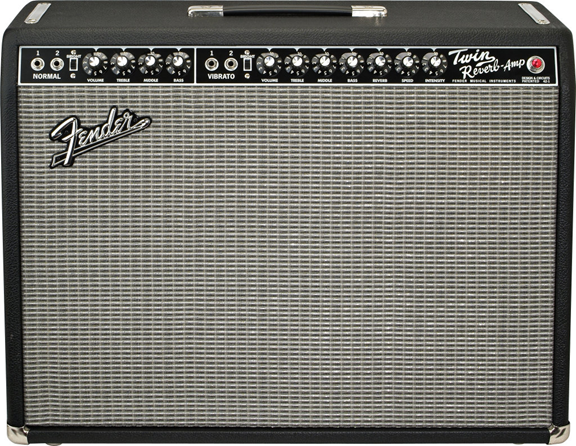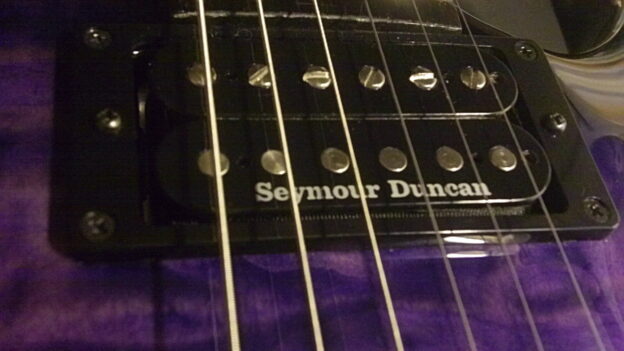by Chad Crawford, PMI Guitar Instructor
The wonderful sound that comes out of an amplifier begins with a tiny electromagnetic impulse in your guitar’s pick-up coil(s). This tiny, constantly varying impulse imposes an electronic signal at the guitar’s output port which travels along the cord into your amplifier. The amplifier receives this signal and sends it through several stages of amplification to produce a signal powerful enough to drive the speaker(s).
An amplifier typically consists of two overall stages of amplification: pre-amp, and power amp. The pre-amp stage is the one that receives the input from your guitar and processes it into a larger signal with tone alterations for presentation to the power amp stage. The pre-amp is where the amplifier allows you to alter specific tonal features such as bass, mid range, and treble, as well as apply built-in effects such as distortion (a.k.a. gain) and reverb.
The job of the power amp stage is to pick up the output signal from the pre-amp and magnify it up to a power level sufficient to drive your speakers via an output transformer. The purpose of the output transformer is to match the electromagnetic characteristics (impedance) of your amplifier’s power stage to the electromagnetic characteristics of your speaker(s), so that the amplifier will couple the maximum amount of available power to the speakers.
Tube vs. Solid State
It is important understand the difference in response between vacuum tube and solid state amplifiers. Tubes bring two very important characteristics to guitar amplification. First, they inherently add content known as harmonics, also often referred to by guitarists as overtones. In audio amplification outside the realms of guitar, these added audio components constitute an undesirable form of distortion. In guitar amplification they provide a pleasant sounding addition to the otherwise pure guitar tone. Secondly, tubes tends to react more strongly than transistors to changes in input, such that tube amps tend to provide a more sensitive response to the input from the guitar player. This tends to magnify the effect of changes in dynamics provided by variations in pick attack, such that the tube amp feels to many guitarists more like dancing with a willing partner, as opposed to the solid state amp’s more simple and indifferent magnification of the volume. For the less experienced guitarist these differences in response between the two types of amplification may be meaningless, but as experience accumulates these things will become more noticeable.
On some more elaborate amplifiers you may be able to pick off the signal at various stages of amplification for additional processing and/or routing. Many amplifiers have an effects loop which will allow you to insert patch cords after the pre-amp stage that will route the signal to an external effects processor and then back into your amp. Some amps also have a patch port between the pre-amp stage and the power amp stage that allows you to completely separate the two stages. This would allow you for instance to use the pre-amp stage from one amp to provide a signal to the power stage of another amp.
Tone Implications of Combo vs. Head/Cabinet
Guitar amps come in two basic physical configurations: combo and head/cabinet. A combo (short for combination) amp has the electronic circuitry and the speaker(s) all in one convenient box. Alternatively, you may wish to keep your amplifier itself separate from the speakers so that you have tonal options by matching up different amplifiers and speakers, as well as weight management for heavier amps and speaker cabinets. In this case you would want the amplifier in a box by itself. We call these amp-only boxes amplifier heads, or head for short. So we attach the head via a speaker cable (not the same cable as a guitar cable!) to a separate box that has only a speaker or multiple speakers. This is why many amp heads have several speaker output ports, so that you can use the head to drive speaker cabinets of varying load (impedance).
The most popular head/cabinet arrangement is the half-stack. The half stack is a head sitting on top of a large speaker cabinet with typically four speakers, usually 12 inch diameter speakers. The name half stack is a derivative of the stack, an amp with one head sitting atop two speaker cabinets with four speakers each. Hence the name stack – it is literally a stack of big boxes. A stack is a big, heavy, and loud amplifier arrangement that is only needed for the largest of venues, either a large arena or outdoors. A half stack, while still bulky and loud, is more manageable and thus is suitable for a wider variety of venues.
The combo amp may contain one speaker of sizes from 4 inch up to 12 inch. Some combos contain two twelve inch speakers, and some contain four ten inch speakers. More speakers means more power, and also more bass response. My rule of thumb … for good tone I recommend that if the combo amp has only one speaker, then stick with amps that have a 12 inch speaker.
Take note of this: you do not need a half stack to achieve high volume levels. A good quality combo with two 12 inch speakers will produce volumes comparable to a half stack of similar power. For large live venues the sound that the audience hears is coming through the much louder P.A. system anyway, via a microphone on the guitar amp speaker.
Fender vs. Marshall Tone
There are two basic guitar amplifier architectures on the market, both based on amps designed around specific power stage tubes. One is the Fender sound which is a clean tone based on the 6L6 tube. The Fender amps are coveted for pristine clean tones at higher volumes (a.k.a headroom – the amount of volume an amp can produce before distorting). The Fender sound is great for Blues, Jazz, and Country styles. The Marshall amps are based on the EL34 tube which produces a desirable distortion or break-up at moderate volume levels. This makes them desirable for any kind of guitar music that features distortion, such as rock or metal.
Since most guitarists use additional effects pedals to add various effects, there is some overlap between these tones. Most tube amps on the market today are some kind of imitation or derivative of the Fender or Marshall amps. Another popular tone is the EL84 tube tone associated with the classic VOX amps and often used on lower power tube amps. The EL84 tone has a sharp bright treble response and less bass response than the physically larger 6L6 and EL34 tubes.
If you want to know whether your amp is a Fender or Marshall type of amp, just check the power tubes. However, every amp consists of many components and built-in tone coloring characteristics, so you will not be able to know for sure what an amp sounds like without actually playing through it. There are many good quality amps on the market today besides Fender and Marshall. Let your ears be the judge. I prefer the tone of a Marshall, although I have heard great sounding tones coming from many other amps.
Amp Simulators
Modern computer technology has brought us guitarists the ability to include computers in our arsenal of music making tools. Popular simulators such as Pod Farm, Amplitube, and Guitar Rig allow us to plug our guitar into our computers via an interface box and then play through the computer. This is a great tool for practicing, as the simulation software will allow us to mimic a wide variety of tones from different iconic amplifiers and effects, all with just a few clicks of a mouse. For practicing guitar and learning about various amps and effects, this is the best thing that has happened to guitarist in decades. These simulators, in conjunction with other computer programs, also allow for pro-quality recording of your playing right in your bedroom, at volumes that will not disturb your neighbors or even the people in the next room. Assuming you already have a computer, these simulators are not nearly as expensive as a real guitar amp of good quality, so I highly recommend a simulator program for those new to electric guitar. After spending some time with a simulator you will have a better idea of the tone variation among the popular amps, so you will have a better sense of what you are looking for when you go to invest in a real amp.
Miscellaneous Considerations …
Guitar amps often have multiple channels to allow you varying tonal options from the same amp, from pristine clean to raucous distortion. In addition, each of these channels will usually have separate volume controls and maybe even separate input (gain) and output volume controls. Finally there will be one master volume control that controls the final output volume of the amp regardless of which channel you select. It is important to understand that there is a significant difference in volume from your guitar when you are playing rhythm versus solo. The multiple amp channels allow you to change for instance from a clean or slightly distorted tone for chords, to the richer harmonic content and increased sustain of distortion for playing individual notes of a solo. You will lose a significant amount of volume from the guitar when you change from playing chords to playing individual notes, such that if you set your amp up during sound check to match the band volume when you are playing chords, when you go to play solo at the same volume you will be drowned by the band. So you must set the volume on your solo channel significantly higher than that of your rhythm channel.
It is important to note that the amp tone will change drastically as you increase the volume. For instance, at low volumes the bass response will be weak so that you have to turn the amp up to get a balanced sound across the frequency spectrum. The electronic components will affect the tone to different degrees at different power levels. Power tubes deliver a certain coveted distortion that only appears when the tube is pushed to higher power levels. Speakers have a certain inherent stiffness so that they will only yield their best tones when pushed into lively motion to a certain degree (speaker excursion). Altogether, what this means is that the best electric guitar tones often come at the price of higher volumes. It is a never ending quest for guitarists to coax a good tone from our electric guitar amps at lower volumes, especially with distorted tones. It can be done, but it will take some time and effort learning how to tweak your amp.
Any given guitar amp is going to produce a wide variety of tonal qualities based on the options available on the amp, the guitar and effects plugged into the amp, and importantly the playing characteristics of the player playing through the amp. Pros often have their amps modified away from the manufacturer designs. So just because a certain guitarist you enjoy uses a certain kind of amp, that does not necessarily mean you will be able to reproduce their tone easily by purchasing the same amp. Before you rush out and buy the same amp as your guitar hero, be sure you play through a number of amps first. It may be that you will find your preferred tone coming from a box that you wouldn’t have expected.
Copyright © 2024 Palmetto Music Institute. All Rights Reserved.


